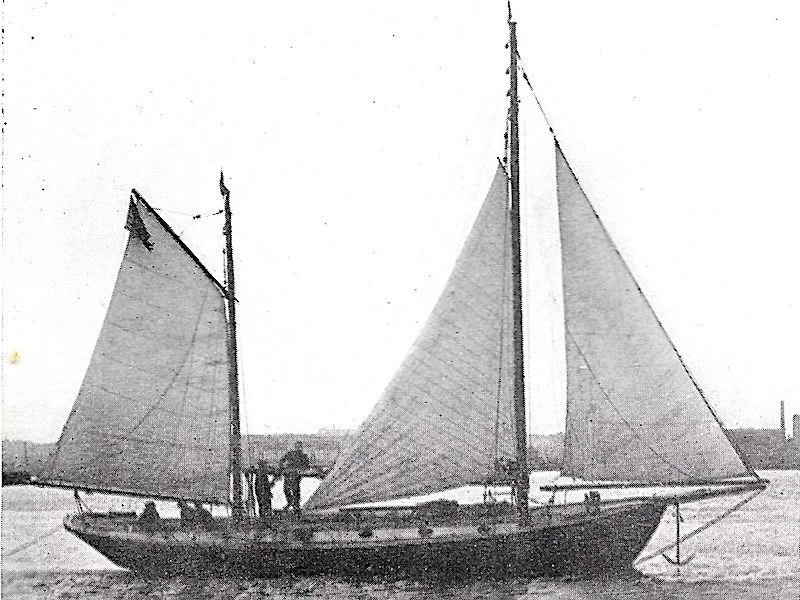Adventurous Use of the Sea
Was Bill Nutting a Nutcase?
By Charles Doane from the exceptional WAVETRAIN website
I’ve been remiss here. I got a copy of this book some time ago, handed me direct and personal from its author, Tim Murphy, autograph included. I read big chunks of it most immediately and learned: it’s a great book! But I was on my boat at the time, and the book got lost in the jumble of the boat, which probably is appropriate. Anyway… I have now finally extracted the book from the jumble of the boat and am here to pimp it to you.
What it is is this: a celebration of the Cruising Club of America (CCA), on the occasion of its 100th anniversary, recounting the adventures of various club members.
Subject number one, very appropriately, is William Washburn Nutting, the man who first conceived the club after crossing the Atlantic to England with two crew (see photo up top; that’s Nutting on the right) in 1920 aboard a 45-foot gaff ketch named Typhoon.
If you’ve ever sailed in a Bermuda Race, long administered by the CCA in conjunction with the Royal Bermuda Yacht Club, you may have noted that the CCA is very safety conscious. Safety fascists is how I actually thought of them, when compelled to pay for and sit through a long and tedious Safety at Sea seminar simply so I could crew on a Bermuda Race boat.
So I was surprised, on reading the first two chapters of Tim’s book, to learn that Bill Nutting, the CCA’s founding spirit and first commodore, essentially had little more than contempt for the concept of safety at sea. As he wrote in his book The Track of the Typhoon, which recounts his Atlantic circle cruise: “I feel what American yachting needs is less common sense, less restrictions, less slide rules and more sailing. [I]s ‘Safety First’ going to become our national motto?”
And you have to give Nutting credit: he lived, and ultimately died, adhering to his anti-safety credo, insisting to the end that the true purpose of ocean sailing was simply “the fun of the thing.”
Typhoon was designed by William Atkin, with lots of input from Nutting and his buddy/crew Casey Baldwin
Reading of Nutting’s adventures, you’ll likely notice he liked to sail at the wrong time of year and that people on his boats often fell overboard. He also was good at sailing fast. His west-east transat from Nova Scotia to England aboard Typhoon featured several daily runs of over 170 miles. On arriving at Cowes, Nutting encountered, among several other sailing luminaries, one Claud Worth, then vice-commodore of the Royal Cruising Club, and he wondered: “Why can’t such a club be started on this side of the Atlantic?”
The fact that Nutting actually, and literally, revelled in misadventure was made clear during Typhoon’s return east-west transat to New York. He described the day, north of the Azores, in which the boat lost its mizzenmast while hove to in a gale as “the most exciting one thus far,” further noting: “we should be discouraged if we allowed ourselves to indulge in such feelings.”
Departing the Azores in late October, arriving finally off New York in mid-November, Nutting and company suffered two full knockdowns, with Typhoon’s masts in the water, over two successive days. The second broaching saw two crew, Jim Dorsett and Uffa Fox (yes, that Uffa Fox!), lost overboard. Fox managed to get back aboard unaided, but Dorsett ended up far from the boat. Fortunately, he managed to grab a line trailing astern and after a huge effort the rest of the crew hauled him back aboard. Afterwards, the entire crew left the boat to herself, retired below, broke out a bottle of cognac and “sang everything we could think of out of sheer joy.”
Uffa Fox later wrote: “It was a great experience, which I would not have missed for the world.”
Typhoon’s crew (minus Nutting) on the east-west transat passage: Charles Hookey, Manson Dillaway, Uffa Fox, and Jim Dorsett
Typhoon under trysail after finally arriving in New York
It was in New York just a few days later, in Typhoon’s saloon, still steeped in fuel oil from the knockdowns, that Nutting, after sharing around a large amount of brandy, proposed to a group of friends that they create the Cruising Club of America.
And here’s yet another fun fact about Bill Nutting: he was the one who actually first conceived of the boat that ultimately became the renowned Westsail 32. Having become interested in Colin Archer’s Norwegian rescue boats, the redningskoiters, he worked up preliminary drawings of a smaller 32-foot version and asked William Atkin to refine them. As Atkin later wrote: “It is more than too bad that Mr. Nutting did not live to see the popularity of his child.”
Nutting did intend to have a boat built from Atkin’s design, but then decided instead to buy a converted rescue boat in Norway. He named this boat Leiv Eiriksson and set out with two crew to sail her back to America, following the old Viking high-latitude route. They made it as far as Greenland, but after setting out from there for Labrador they disappeared and were never seen again.
All this (in much greater detail, of course) in just the first 58 pages of Tim’s book!
In the many subsequent pages, you’ll also learn about the exploits of various other CCA members. These include some classic old characters, such as John Alden, Olin and Rod Stephens, Carleton Mitchell, and Irving Johnson, as well as more contemporary mariners, like Stan and Sally Honey, Rich Wilson, and Roger Swanson, to name but a few. I was particularly pleased to find a chapter on my old SAIL Magazine colleague Tom Linskey and his wife Harriet, who have spent years distributing school books throughout the Caribbean aboard their Dolphin 460 catamaran, Hand Across the Sea.
The book not only profiles people, but also the boats they’ve sailed, and considered as a whole comprises a fantastic synopsis of how both the cruising community and cruising boats have evolved over the past century.
You can score your own copy here.
Adventurous Use of the Sea: Formidable Stories of a Century of Sailing from the Cruising Club of America
By Tim Murphy; edited by Sheila McCurdy
Seapoint Books (2022)
368 pp.






